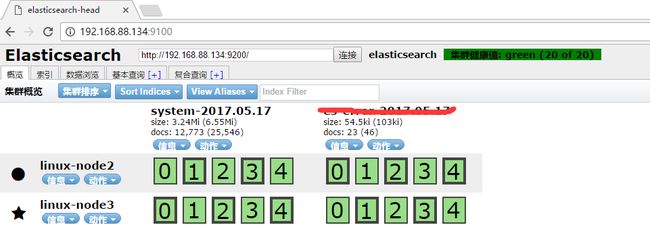Logstash日志收集实践
一、安装logstach
[root@linux-node2 ~]# tar xf /usr/local/src/logstash-5.2.2.tar.gz -C /usr/local/
[root@linux-node2 ~]# mv /usr/local/logstash-5.2.2 /usr/local/logstash
二、启动logstash
-e:在命令行执行
首先,需要先了解以下几个基本概念:
logstash收集日志基本流程: input-->codec-->filter-->codec-->output
1.input:从哪里收集日志,即输入 ;{stdin标准输入}
2.filter:发出去前进行过滤
3.output:输出至elasticsearch或redis消息队或者其他队列里面;{stdout标准输出}
4.codec:输出至前台,方便边实践边测试
5.数据量不大日志按照月来进行收集
1、通常使用rubydebug方式前台输出展示以及测试
[root@linux-node2 ~]# /usr/local/logstash/bin/logstash -e 'input { stdin{} } output { stdout{ codec => rubydebug} }'
Sending Logstash's logs to /usr/local/logstash/logs which is now configured via log4j2.properties
[2017-05-17T21:33:33,848][INFO ][logstash.pipeline ] Starting pipeline {"id"=>"main", "pipeline.workers"=>2, "pipeline.batch.size"=>125, "pipeline.batch.delay"=>5, "pipeline.max_inflight"=>250}
[2017-05-17T21:33:33,872][INFO ][logstash.pipeline ] Pipeline main started
The stdin plugin is now waiting for input:
[2017-05-17T21:33:33,908][INFO ][logstash.agent ] Successfully started Logstash API endpoint {:port=>9600}
备注:
也可以直接采用标准输入和标准输出的方式直接输出,即
[root@linux-node2 ~]# /usr/local/logstash/bin/logstash -e 'input { stdin{} } output { stdout{} }'
2、将logstach标准输入的内容输出到elasticsearch中
[root@linux-node2 ~]# /usr/local/logstash/bin/logstash -e 'input { stdin{} } output { elasticsearch { hosts => [“192.168.88.134:9200”] } }'
3、将logstach的信息写入到elasticsearch中,并前台展示及测试
[root@linux-node2 ~]# /usr/local/logstash/bin/logstash -e 'input { stdin{} } output { elasticsearch { hosts => [“192.168.88.134:9200”] } stdout{ codec => rubydebug } }'
三、logstach收集日志
1、收集syslog系统日志
[root@linux-node2 ~]# cat system.conf
input {
file {
path => "/var/log/messages"
type => "system"
start_position => "beginning"
}
}
output {
elasticsearch {
hosts => ["192.168.88.134:9200"]
index => "system-%{+YYYY.MM.dd}"
}
}
[root@linux-node2 ~]# /usr/local/logstash/bin/logstash -f system.conf
2、收集elasticsearch的访问日志
[root@linux-node2 ~]# cat es_access.conf
input {
file {
path => "/var/log/elasticsearch/elasticsearch.log"
type => "es-access"
start_position => "beginning"
stat_interval => "10" #设置收集日志的间隔时间,单位是s
}
}
output {
if [type] == "es-access" {
elasticsearch {
hosts => ["192.168.88.134:9200"]
index => "es-access-%{+YYYY.MM.dd}"
}
}
}
[root@linux-node2 ~]# /usr/local/logstash/bin/logstash -f es_access.conf
3、收集tcp日志,并输出到redis中
3.1 配置文件编写
[root@linux-node2 ~]# cat tcp.conf
input {
tcp {
type => "tcp_port_6666"
host => "192.168.88.134"
port => "6666"
mode => "server"
}
}
output {
redis {
host => "192.168.88.134"
port => "6379"
db => "6"
data_type => "list"
key => "tcp_port_6666"
}
}
[root@linux-node2 ~]# /usr/local/logstash/bin/logstash -f tcp.conf
3.2 向666端口发送数据几种方式:
echo "heh" |nc 192.168.88.134 6666
nc 192.168.88.134 6666 < /etc/resolv.conf
echo hehe >/dev/tcp/192.168.88.134/6666
4、收集java日志
es是java服务,收集es需要注意换行问题
[root@linux-node2 ~]# cat java.conf
input {
file {
type => "access_es"
path => "/var/log/elasticsearch/elasticsearch.log.log"
codec => multiline {
pattern => "^\["
negate => true
what => "previous"
}
}
}
output {
redis {
host => "192.168.88.134"
port => "6379"
db => "6"
data_type => "list"
key => "access_es"
}
}
[root@linux-node2 ~]# /usr/local/logstash/bin/logstash -f java.conf
备注:
1、 grok 内置正则表达式地址
2、将java日志格式设置为json格式
修改tomcat的server.xml文件
5、收集nginx日志
5.1 安装nginx,并将nginx改成json格式输出日志
#http段加如下信息(日志位置根据业务自行调整)
log_format json '{ "@timestamp": "$time_local", '
'"@fields": { '
'"remote_addr": "$remote_addr", '
'"remote_user": "$remote_user", '
'"body_bytes_sent": "$body_bytes_sent", '
'"request_time": "$request_time", '
'"status": "$status", '
'"request": "$request", '
'"request_method": "$request_method", '
'"http_referrer": "$http_referer", '
'"body_bytes_sent":"$body_bytes_sent", '
'"http_x_forwarded_for": "$http_x_forwarded_for", '
'"http_user_agent": "$http_user_agent" } }';
access_log /var/log/nginx/logs/access_json.log json;
5.2 编写收集nginx访问日志
[root@linux-node2 ~]# cat nginx.conf
input {
file {
type => "access_nginx"
path => "/var/log/nginx/access_json.log"
codec => "json"
}
}
output {
redis {
host => "192.168.88.134"
port => "6379"
db => "6"
data_type => "list"
key => "access_nginx"
}
}
[root@linux-node2 ~]# /usr/local/logstash/bin/logstash -f nginx.conf
6、消息队列解耦
6.1 将所有需要收集的日志写入一个配置文件,发送至redis服务。
[root@linux-node2~]# cat input_file_output_redis.conf
input {
#system
syslog {
type => "system_rsyslog"
host => "192.168.88.134"
port => "514"
}
#java
file {
path => "/var/log/elasticsearch/elasticsearch.log"
type => "error_es"
start_position => "beginning"
codec => multiline {
pattern => "^\["
negate => true
what => "previous"
}
}
#nginx
file {
path => "/var/log/nginx/access_json.log"
type => "access_nginx"
codec => "json"
start_position => "beginning"
}
}
output {
#多行文件判断
if [type] == "system_rsyslog" {
redis {
host => "192.168.88.134"
port=> "6379"
db => "6"
data_type => "list"
key => "system_rsyslog"
}
}
if [type] == "error_es" {
redis {
host => "192.168.88.134"
port=> "6379"
db => "6"
data_type => "list"
key => "error_es"
}
}
if [type] == "access_nginx" {
redis {
host => "192.168.88.134"
port=> "6379"
db => "6"
data_type => "list"
key => "access_nginx"
}
}
}
[root@linux-node2 ~]# /usr/local/logstash/bin/logstash -f input_file_output_redis.conf
6.2 将redis消息队列收集的所有日志,写入elasticsearch集群。
[root@linux-node2~]# cat input_redis_output_es.conf
input {
redis {
type => "system_rsyslog"
host => "192.168.88.134"
port=> "6379"
db => "6"
data_type => "list"
key => "system_rsyslog"
}
redis {
type => "error_es"
host => "192.168.88.134"
port=> "6379"
db => "6"
data_type => "list"
key => "error_es"
}
redis {
type => "access_nginx"
host => "192.168.88.134"
port=> "6379"
db => "6"
data_type => "list"
key => "access_nginx"
}
}
output {
#多行文件判断
if [type] == "system_rsyslog" {
elasticsearch {
hosts => ["192.168.88.134:9200","192.168.88.136:9200"]
index => "system_rsyslog_%{+YYYY.MM.dd}"
}
}
if [type] == "error_es" {
elasticsearch {
hosts => ["192.168.88.134:9200","192.168.88.136:9200"]
index => "error_es_%{+YYYY.MM.dd}"
}
}
if [type] == "access_nginx" {
elasticsearch {
hosts => ["192.168.88.134:9200","192.168.88.136:9200"]
index => "access_nginx_%{+YYYY.MM.dd}"
}
}
}
[root@linux-node2 ~]# /usr/local/logstash/bin/logstash -f input_redis_output_es.conf
7、将logstash写入elasticsearch(适合日志数量不大,没有redis)
[root@linux-node2 ~]# cat all.conf
input {
#system
syslog {
type => "system_rsyslog"
host => "192.168.88.134"
port => "514"
}
#java
file {
path => "/var/log/elasticsearch/elasticsearch.log"
type => "error_es"
start_position => "beginning"
codec => multiline {
pattern => "^\["
negate => true
what => "previous"
}
}
#nginx
file {
path => "/var/log/nginx/access_json.log"
type => "access_nginx"
codec => "json"
start_position => "beginning"
}
}
output {
#多行文件判断
if [type] == "system_rsyslog" {
elasticsearch {
hosts => ["192.168.88.134:9200","192.168.88.136:9200"]
index => "system_rsyslog_%{+YYYY.MM}"
}
}
if [type] == "error_es" {
elasticsearch {
hosts => ["192.168.88.134:9200","192.168.88.136:9200"]
index => "error_es_%{+YYYY.MM.dd}"
}
}
if [type] == "access_nginx" {
elasticsearch {
hosts => ["192.168.88.134:9200","192.168.88.136:9200"]
index => "access_nginx_%{+YYYY.MM.dd}"
}
}
}
[root@linux-node2 ~]# /usr/local/logstash/bin/logstash -f all.conf
